Roman dodecahedra between Southeast Asia and England, part 3
« previous post | next post »
I stopped short when I passed by this piece of gym equipment in a kindergarten playground near my home.
"What," I thought, "another Gallo-Roman dodecahedron right in my own backyard? Am I seeing things because I've been too preoccupied with Gallo-Roman dodecahedra (GRd) for the past few weeks?"
But this was not a dodecahedron; it was (I think) a modified decahedron, and SFAIK it has nothing to do with the alphazodiac.
Speaking of which, here is a dodecahedron created by a Slovakian astronomer, each face labeled with its appropriate constellation of the zodiac:
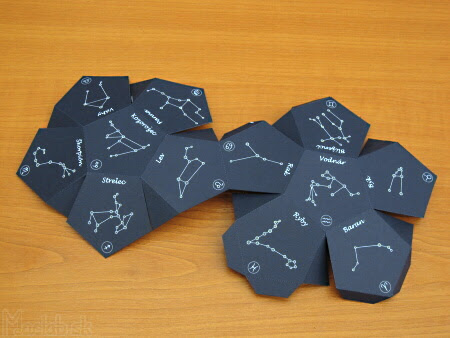
Folded and glued:
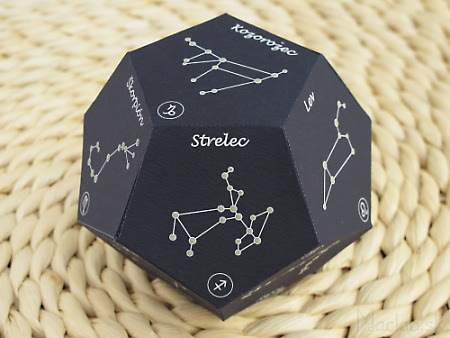
(source)
Here is an Italian leather and wood dodecahedron decorated with the signs of the zodiac:
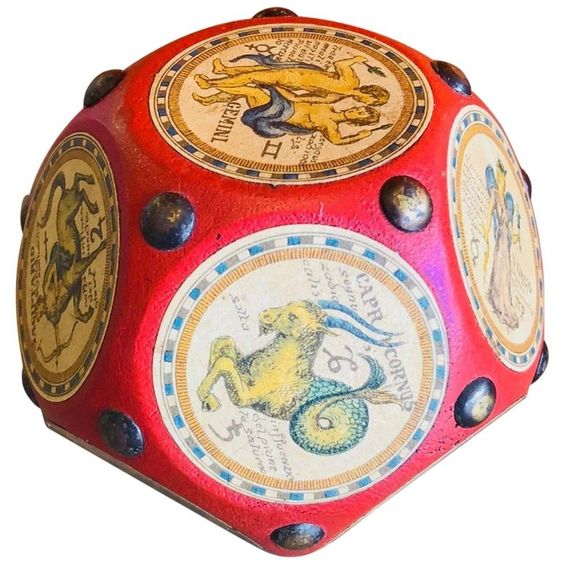
(source)
The knobs at the vertices are said to be for the protection of the faces when the device is placed on a surface. I myself, during an idle moment today, thought that, whatever else they may have been intended for, the knobs keep the device from rolling over onto another face. The five projecting "feet" keep the dodecahedron solidly and securely seated (Gr -edron < hedra, a side, base, seat < IE base *sed- > L sedere, sit) (Collins)
As for the purpose / use of the dodecahedra, Thomas Lee Mair offered these helpful notes:
I was relieved to see that someone (Brian?) mentioned a possible military association, such as rangefinding. The organization of the legions is a subject worthy of consideration. We all know the importance of the aquila to the generals, and to the emperor. I will never forget the scene in "I, Claudius" when the Caesar Augustus is informed that his armies have been lost, in Dacia I believe. Caesar, played by Brian Blessed, enters into an apoplectic fit, screaming like a baby having a tantrum: "I want my Eagles back! I want my Eagles back!" It's an unforgettable scene, and not easily understood until we realize that the Eagles were the embodiment of the Roman Legions. The tantrum is frightening to witness.
There are so many plausible ideas mentioned in the comment section to your previous two posts that I hesitate to put forward another idea, based purely on speculation. To me it seems apparent that these were restricted items, reserved either for scientists, scholars, astrologists, priests, or generals. Otherwise they would appear in the literature. It might be worth considering if these were symbols of military authority that were held in secret, to be returned to Rome or to be buried if the legion were in desperate straits.
This reasoning is compatible with the GRd as astronomical-calculatory device hypothesis that I thought they were from the beginning. It also has the added advantage of explaining where they have been found. I surmise that the GRd were like basic, simplified, portable astrolabes (precursors to the sextant), which were amazingly versatile and could solve more than a thousand different kinds of astronomical and mathematical problems.
In modern times, the Irish mathematician Sir William Rowan Hamilton (1805-1865) invented a mathematical game called the Icosian game, which involved finding a Hamiltonian cycle that followed the edges of a dodecahedron and passes through all of its vertices. It came close to becoming a commercial success and he even created a travel version of the game.
Here are four blog posts on "Roman Dodecahedrons" (I, II, III, IV) by a scientifically minded Australian engineer tinkerer named Gavin. They are extraordinarily detailed and attentive to the demands of verifiability and falsifiability. Although he is wedded to the idea that the GRd are string games in the Hamiltonian mode, I am pleased that he takes into consideration the astronomical, zodiacal, calendrical aspects of the device.
Selected readings
- "Roman dodecahedra between Southeast Asia and England, part 2" (5/12/24)
- "Ask Language Log: One = only one?" (7/22/11) — philosophy of Sir William Hamilton
- "Roman dodecahedra between Southeast Asia and England" (4/30/24)
- "Wheat and word: astronomy and the origins of the alphabet" (3/15/24) — with references to seven substantial papers on this subject by Brian Pellar
- "The Alphabet and the Zodiac" (12/6/22)
[Thanks to Jing Hu]
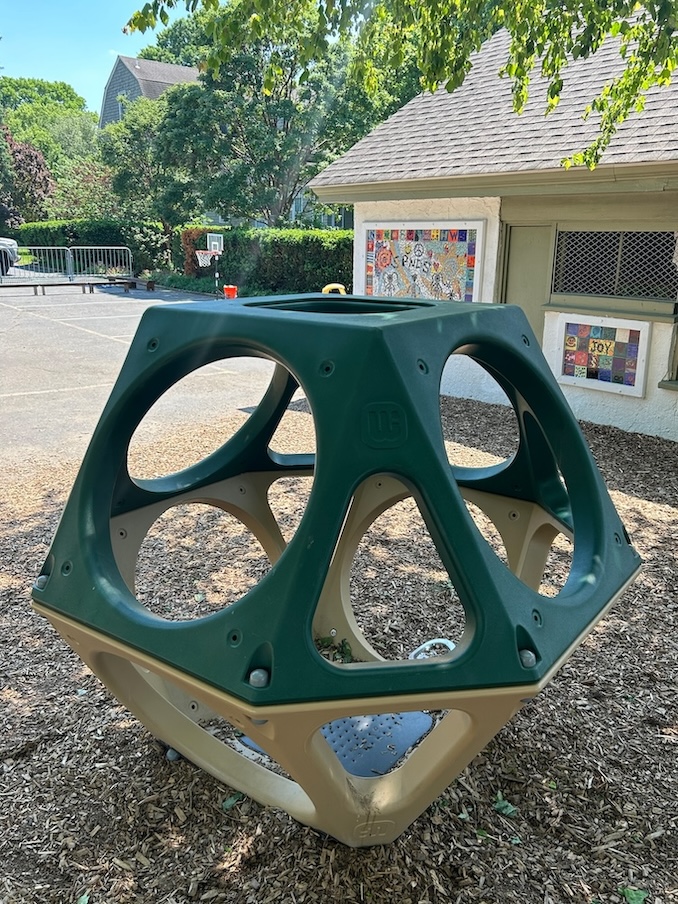
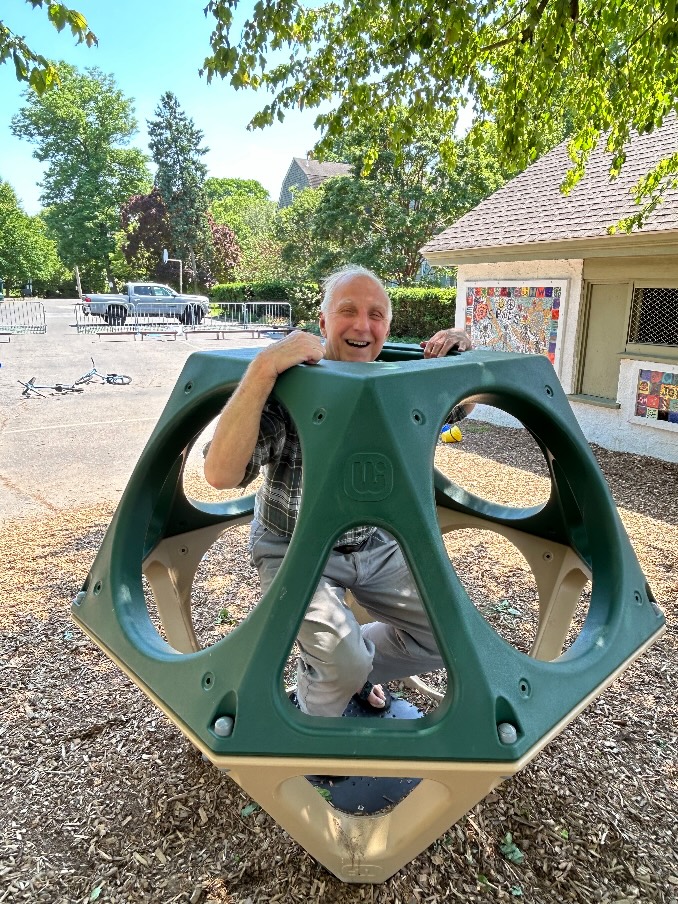
Keith Ivey said,
May 24, 2024 @ 1:32 pm
The shape is a square bicupola, with the triangles squashed so that they're not equilateral, meaning that the shape viewed from above is not a regular octahedron. If the triangles were equilateral, the shape would be squatter.
Haamu said,
May 24, 2024 @ 1:54 pm
You can nail it down further and call it a square orthobicupola since the triangles on the top half are attached to triangles on the bottom. Give either half a 1/8 twist (so triangles attach to squares and vice versa) and you have a square gyrobicupola.
Martin said,
May 24, 2024 @ 3:49 pm
Thomas's comments quoted in the OP are a little inaccurate. Augustus is said by Suetonius to have reacted in this way to the disaster of the Teutoburg Forest, and he wanted the return of the legions, not the eagles — I'm sure Graves gets this right and I would have guessed the TV series did too:
Adeo denique consternatum ferunt, ut per continuos menses barba capilloque summisso caput interdum foribus illideret vociferans: "Quintili Vare, legiones redde!" diemque cladis quotannis maestum habuerit ac lugubrem.
It's true that the Romans subsequently recovered two of the three lost eagles in retaliatory raids against the German tribes
Seth said,
May 24, 2024 @ 7:18 pm
Note how much text and imagery is on the faces of those zodiac dodecahedra. And no holes, that would interfere with the text and imagery. The fact that there's absolutely no text or even a symbol on any of the Roman dodecahedra (apart from some circles around the holes) inclines me to believe that they are strictly utilitarian. Is there even some sort of craftman's brand on any of them?
They can't be for string games, because the uneven sized holes are a constant feature, and those holes would not matter for a string game. Any explanation must account for those holes.
Lucas Christopoulos said,
May 25, 2024 @ 2:29 am
could the dodecahedra have been used by moving it on maps?
AntC said,
May 25, 2024 @ 5:22 am
could the dodecahedra have been used by moving it on maps?
Aha! with two lenses in the paired holes, of different sizes = different magnifications. And the knobs to make the lenses stand a little away from the map surface. Something like a microscope. Is there evidence of glass or crystal fragments amongst the archaeological finds?
'Lens' from Latin for lentil. "Pliny also has the earliest known reference to the use of a corrective lens …"
AntC said,
May 25, 2024 @ 5:41 am
Playground icosahedron climbing frame in my local kids park.
(At least I think not technically an icosahedron; I count 6+6+6+6+4+4 triangular faces, if the 'underground' quadrilateral is symmetric with the top; more a glorified cube; one of those semi-regular solids. Doubtless the first two commenters here will correct me.)
Antonio said,
May 25, 2024 @ 10:14 am
Is it possible that, similar to the Italian leather and wood dodecahedron shown here, something was originally inserted into the holes, made of a less durable material which has since rotted away?
Peter Erwin said,
May 25, 2024 @ 10:36 am
This reasoning is compatible with the GRd as astronomical-calculatory device hypothesis that I thought they were from the beginning…. I surmise that the GRd were like basic, simplified, portable astrolabes (precursors to the sextant), which were amazingly versatile and could solve more than a thousand different kinds of astronomical and mathematical problems.
I'm sorry, but that's still nonsense. I could assert that these are weapons, or thermometers, or torture devices, or long-distance communicators, or things you use to tune musical instruments, with exactly as much plausibility.
And these objects are absolutely nothing like astrolabes (I find myself a bit skeptical that you even looked at the illustrations in the Wikipedia article). Please read this article before you start asserting things about "astrolabes":
https://electronics.howstuffworks.com/gadgets/clocks-watches/astrolabe.htm
Peter Erwin said,
May 25, 2024 @ 11:00 am
I will note a few things I found out about ancient dodecahedrons (which certainly are odd and intriguing objects).
In a comment to a previous post, Brian noted a dodecahedron in a museum in Geneva with zodiacal symbols. There's some good discussion of ancient dodecahedrons here, including more information about the Geneva object:
So the design and construction of the Geneva dodecahedron are quite different from the GRds, which is one strike against the "all ancient dodecahedrons are related to the zodiac" argument. (And it's just as useless for any kind of astronomical observation as the hollow bronze knobby ones.)
Are there any other examples of ancient dodecahedrons? A few, which are curiously different. This article describes "A Dodecahedron of Rock Crystal from the Idaean Cave" (in Greece, 1st Century AD), and provides some useful background on similar ancient artifacts. After noting the existence of icosohedrons (20-sided regular polyhedrons) with numbers from 1 to 20, understandable as dice for gaming, it adds, "dice with 12 faces, inscribed with the first twelve numbers in Latin or Greek, are less common. Examples are known from Germany (made of bronze, with Latin numerals), Antioch (of red stone, with Greek numerals) and Egypt (of black stone, with Greek numerals)."
The article mentions a hypothetical use for such objects: "Based on the information on divinatory practices contained in the Sortes Sangallenses, Heinevetter saw in the dodecahedral dice an instrument of divination. The Sortes Sangallenses is a collection of oracular responses (third century A.D.?), divided into chapters, of which each contains twelve oracles. The enquirer used a dodecahedral die in order to find the response to his question …"
The odd thing about the Idaean rock-crystal dodecahedron is that it is inscribed with numbers running from 1 to 10, and then 15 and 20. "The closest parallel is a dodecahedral die made of rock crystal found in a Roman grave in Patrae. It is inscribed (in Greek characters) with the numbers 1, 2, 3, 6, 7 (Z, or perhaps N = 50), 10, 11, 15, 18, 20, 30, and 40."
So most ancient (non-hollow knobby) dodecahedrons were not inscribed with zodiacal signs, and weren't always numbered from 1 to 12, either.
Finally, it occurs to me that an obvious use of knobs is stabilization: they would prevent the GRd from being easily knocked over if they are placed on the ground (or a table) — which argues against their being useful as dice, at least, since you want dice to roll easily. (Which is why the tetrahedral d4 is such an awkward die in Dungeons & Dragons…)
Chris Button said,
May 25, 2024 @ 11:36 am
Why does no-one want to talk about the evidence from SE Asia:
https://journals.openedition.org/archeosciences/docannexe/image/2072/img-3-small580.jpg
Haamu said,
May 25, 2024 @ 2:58 pm
@AntC — In order to convince myself of what exactly is going on with your playground shape, I had to repair to Google Street View to get an additional angle.
Although I am by no means a professional at this, I think it's safe to say (assuming it's symmetrical if we pull it out of the ground) that this is a tetrakis cuboctahedron.
Since this is Language Log, I'll note that my fascination here is as much linguistic as it is mathematical, given the highly productive naming system that has been devised for these polyhedra, a taste of which can be found in the "Names" section of Wikipedia's article on the Johnson solids, as well as various articles linked from there. A fun way to geek out…
Victor Mair said,
May 25, 2024 @ 6:21 pm
@Chris Button
Thank you so much for showing us the SE Asia examples. I was wondering what they are like.
Noticed several things:
1. They are tiny, almost the size of a bead.
2. They have holes, to be sure, but that's because the sides are essentially rings.
3. The GRd have 12 pentagonal plates for sides.
4. That type of construction saves material and reduces weight.
5. The knobs, which I mentioned above for the full size GRd as being "seats" to stabilize the devices when they are placed on a surface, are also used to fasten the sides together.
6. The fact that the SEAd are incorporated into bracelets and necklaces indicates that they have symbolic significance.
I reiterate that the dodecahedra undoubtedly developed multiple functions, but — as Plato (who should know best about the meaning of the Platonic solids) pointed out from the start — the dodecahedron is for inscribing the constellations on the cosmos. If you don't take the twelveness of the dodecahedron seriously, you're not taking Plato seriously. Indeed, you're not even being commonsensical.
More about that in another post.
Seth said,
May 25, 2024 @ 7:29 pm
@ Chris Button – those looks to me like they are ornamental representations of the real item, somewhat like earrings or a brooch which which have small, nonfunctional ornamental objects which are miniature replicas of the functional object.
That does tend to suggest to me that these were an item which the general population would know about, even if not used every day.
@ AntC – I think a lens application would require too many lens. It would also require a padded case of some sort to protect the lens from being scratched or broken (if course, the case may not have survived). I'd also think a few intact lenses would have been found.
Abbas said,
May 26, 2024 @ 2:27 am
The commercial name of the outdoor implement that temporarily trapped VHM is Ruby Qube. A google search will display several vendors, if you are intersted.
David Morris said,
May 26, 2024 @ 6:27 am
Robert Graves has Claudius playing dice at various times, most notably as he is waiting for news of the invasion of Britain. At the moment it does, he rolls a 'Venus', which explains is three sixes, which presumably means cubical dice.
Victor Mair said,
May 26, 2024 @ 6:49 am
Oh, wow, Abbas!
Thanks for calling Ruby Qube to our attention.
They usually are installed in clusters — 3, 4, 5, or even more — and you can connect toddler slides to them. When many of the units are installed, it can become an expensive proposition (thousands of dollars).
I would have a lot of fun crawling through a multi-unit installation and going down the slide.
When I was a little kid, I made things sort of like that out of big cardboard boxes from the local appliance store to crawl through and sleep / hide in.
Rodger C said,
May 26, 2024 @ 11:03 am
Regarding the use of polyhedra for divination, I see that no one has invoked the Magic 8-Ball, a common toy of my childhood.
David Morris said,
May 26, 2024 @ 6:01 pm
My search showed more results for Rubik's Cube.
Victor obviously had a Ruby Qube's-day.
Brett said,
May 27, 2024 @ 3:07 pm
@Martin: In I, Claudius, it does talk about Augustus calling for the Eagles back, as well as the "Regiments." However, Claudius's narration does not claim that was what the emperor actually said, only that it was what he was said to have said, in "a soldiers’ marching-ballad called The Three Griefs of Lord Augustus, composed in the rough tragi-comic style of the camp, which was sung many years later by the regiments stationed in Germany."